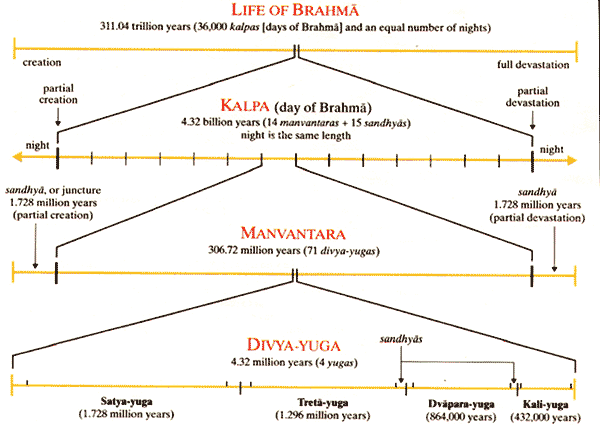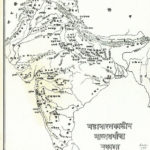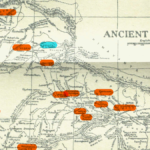“History became Legend, Legend became Myth”. This most famous of lines from a modern movie is emblematic of human attitudes towards civilizational memory. When timescales become incredulous, the story is called “Legend”, when they become mind-boggling the story is called “Myth”. Perhaps that is why since the time of William Jones to his brown successors, every effort has been made to reduce the antiquity of Indian history and Indic Civilization.
Most Hindus are naturally very (over) accommodative and in their (self-defeating) gullibility, assume all people must be on a similar journey of self-discovery of the Truth. Perhaps that is why Hindus are notorious for their stupidity in routinely anointing foreign or foreign-trained individuals as “saviours”–social media being exhibit A. The reality, however, is that expedience has been the byword of these ‘saviours’, and as even Kissinger remarked in his at least nominal analysis of the Arthasastra, even Cultural/Historical traditions can be subject to manipulation in order to exert political control and dominance [What’s sadder is that Indiots again need an outsider to remind them of this, but then again if only universities from phoreign can be good, same with experts]. But when your m.o. for “merit” is read and regurgitate for marks, no wonder you can’t apply theory in reality. Ironically, Chanakya himself has now become targeted by these self-same “breaking India” forces, with a most ridiculous time period suggestion and even arguing that Chanakya is not the same as Kautilya—in utter contradiction of our tradition. As such, the time has arrived for a concerted, and uncompromising pushback.
Much like the William Jones of yester-year, these modern Western Universalists (and their sub rosa cooperators) are attempting to force-fit Indian history and culture into their Christian or now “Post-Modern” chronology–which invariably suits their “narrative”.
 The Ramayana has gone from a time-honoured tale of Righteousness, Nobility, and Self-Sacrifice to a political instrument for medieval use. Such is the insolence of this ilk. In light of that, since the hypocrisy of these “Ivory Tower Intellectuals” has been exposed, the time has come to assert certain realities: Let Science be Science and let Tradition be Tradition.
The Ramayana has gone from a time-honoured tale of Righteousness, Nobility, and Self-Sacrifice to a political instrument for medieval use. Such is the insolence of this ilk. In light of that, since the hypocrisy of these “Ivory Tower Intellectuals” has been exposed, the time has come to assert certain realities: Let Science be Science and let Tradition be Tradition.
Perhaps that is why those in the realm of Western Humanities live in perpetual fear of the Hard Science empirical experts. As Shivoham has argued, their “closed logic” assumption based, selectively rational constructs fall apart in the face of close scrutiny and examination.
Therefore, let Science be Science, and be taught as Science, let Tradition be Tradition, and be taught as Tradition, and let the prying hands of post-modern, aspiring “acharyas” of the sherry-swilling variety be kept out of the realm of tradition, where only true astika and adhyatmika Acharyas belong. One such realm is Cosmology.
In our previous article, we recounted the life and achievement of the great Emperor, Sagara of the Solar Dynasty. He was one such “legendary” king, and his relevance was not only due to the kingly example of sternness he demonstrated in the face of adversity, but also on account of how it disproves the Colonial and poco-pomo purposeful misinterpretation of the word “yavana” to mean Greek. How could a king from the Satya Yuga be fighting Greeks who did not exist till the first millennium BCE in the Kali Yuga? If you do not know the difference between a Kalpa, a Manvantara, and a Yuga, and that we are in the 5118th year of the Kali Yuga, of the 28th Chatur Yuga, of the Vaivasvata Manvantara, of the Sveta Varaha Kalpa, what business do you have in interpreting and playing interpreter of our philosophical and historical texts?
That is why it is not enough to merely assert a “nationalist narrative” within the conventional history, but to tear down this Colonial Era Christian Cosmology-derived Chronology of 4004 BCE (courtesy William Jones) and actually assert what our Vedic Cosmology actually says. If any buffoon with a Sanskrit certificate from Sheldon Pollock University can cherry pick some words to posit an asinine theory, then the traditional understanding built on guardianship of truth will be lost. That was the traditional reason for varna vyavastha, because the truth would be passed down from father to son, with any deviation from the truth bringing shame on the family. Western “Indologists” have no such need for shame. Without properly understanding that Yavana did not mean Greek or that the Satya Yuga comes long before the present Kali Yuga, our children (and sickular seniors with the maturity of children…) will remain utterly clueless on the internal logic of our tradition and traditional systems. History is most assuredly history, but as the recent findings regarding the Xia Dynasty of China demonstrate, what foreigners derisively called “legend” is often found to be genuine history.
What’s more, there is a cliquish band of idiots that is forever navel-gazing over the alleged superiority of Indra over Vishnu. But this only demonstrates their ignorance of not only the Puranas but the Veda itself [Vishnu himself takes up the position of Indra in the first Manvantara as Yajna/Shatakratu. The present Indra is Purandara (in this current Shraddhadeva/Vaivasvata Manvantara). The next Indra is Bali, of Vamana avatara fame]. This is the danger of deconstruction of systems—you can learn more and more, about less and less. All this is why proper understanding of Vedic Cosmology and the traditional Dharmic method of time-keeping is required. However, for graduates of Witzel academy (and its rw acolytes), such a thought even becomes a question as they do not understand (or refuse to understand) the proper hermeneutics involved in interpreting our traditional texts—and they have the audacity to assert a monopoly over it. What a sad world we live in that degree-holders from phoreign are considered more credible interpreters of our sacred texts than our actual traditionally trained, spiritual Acharyas.
 Therefore, whether in fact our “Legends” are Scientifically and Archaeologically confirmed “History” is for Scientists and Archaeologists, in particular, to verify. But the tradition is the tradition, and for traditional Acharyas alone to assert. Foreign and foreign-trained “academics” and “intellectuals” have no more credibility in this regard and only fools grant them this. Let there be no more confusion.
Therefore, whether in fact our “Legends” are Scientifically and Archaeologically confirmed “History” is for Scientists and Archaeologists, in particular, to verify. But the tradition is the tradition, and for traditional Acharyas alone to assert. Foreign and foreign-trained “academics” and “intellectuals” have no more credibility in this regard and only fools grant them this. Let there be no more confusion.
Per our previous remarks, we will remain true to our word and merely repeat what an actual Acharya, Pandit Sri Kota Venkatachalam wrote of our traditional Dharmic View of Time and our Traditional Vedic Cosmology. Here is what here wrote [Emphasis and Proofing ours].
The following Post was originally published at True Indian History on June 23, 2009
The Age of the Present Creation
According to the Smritis,
18 winks of the eye= 1 Kastha
30 kastas………..=1 Kala
30 kalas ………..=1 Muhurta
30 muhurtas………=1 Day and night.(This Ahoratree is the human day.)
According to Jyotisha.
6 respirations………….= 1 Vighati
60 Vighatikas ………….= 1 Ghatika
60 Ghatikas ……………= 1 Day and night(This Ahoratree is the human day.)
15 days………..= 1 Paksha
2 pakshas………= 1 human month
1 human month = 1 day and night: of the Pitris(Manes),the Sukla Paksha being their day and the Krishna Paksha being their night.
12 Human months or one year = 1 The Ahoratree of the Devas
6 Human months = 1 Ayana, ( From Pushya to Jyesta is day of the Devas, from
Ashadha to Margasira is night of the Devatas.
30 human years = 1 Month of the Devatas.
360 human years or 12 Daiva months = 1 Year of the Devatas
12000 Daiva years or 43,20,000 Years = One Daiva yuga or ordinary Mahayuga
0.4 Mahayuga = 4800 Daiva years = 17,28,000 years = Kritayuga with yugasandi and Sandhyamsa.
0.3 Mahayuga = 3600 Daiva Years = 12,96,000 years = Tretayuga
0.2 Mahayuga = 2400 Daiva Years = 8,64,000 years = Dwaparayuga
0.1 Mahayuga = 1200 Daiva Years = 4,32,000 years = Kaliyuga
1 Mahayuga = Kritayuga + Tretayuga + Dwaparayuga + Kaliyuga
1000 Daiva Yugas or ordinary Maha Yugas or 432 crores of ordinary years = One day time for Brahma. This is Udayakalpa. = 30 Ghaticas for Brahma.
Another 1000 Daiva Yugas or 432 crores of ordinary years = Night for Brahma or Kshaya kalpa
2000 Daiva Yugas or ordinary Maha yugas i. e., 864 crores of ordinary years = One Ahoratree of Brahma.
30 Ahoratrees of Brahma or 6,000 ordinary Mahayugas= One Month of Brahma
12 such Brahma months = One Brahma year.
100 Brahmaic years = Life period of Brahma.
During the day time of Brahma(1000 Mahayugas) , 14 Manus look after this world. Each Manu reigns 71 Mahayugas . In the first day of the fifty first year of Brahma have rolled away the following periods:-
6 Manus = 6 x 71 = 426 Mahayugas = 184,03,20,000
27 Mahayugas of the period of Vivasvata, the seventh Manu = 11,66,40,000
The Kritayuga of the 28th Mahayuga = 0.4 Mahayuga = 17,28,000
The Tretayuga = 00.3 Mahayuga = 12,96,000
The Dwapara = 0.2 Mahayuga = 8,64,000
The Kaliyuga till (Kali 5056 or 1955 A. D.,) = 5,056
__________________
Total.= 426+27+0.9 Mahayugas + 5056 years = 196,08,53,056 years
___________________
Seven Jalapralayas each of duration of a Kritayuga
= 7*0.4 Mahayugas =2.8 Mahayugas = 7 * 17,28,000 = 1,20,96,000
_________________
Total. 197,29,49,056 years
_________________
and this is the time since Brahma
woke up on the first day of his
fifty first year and to get at the
age of this creation, DEDUCT from
this, 1,70,64,000 years being the
time of Brahma’s Dhyana or
contemplation before beginning to
issue life. .. … … … 1,70,64,000
_______________
Time since creation began upto 1955 A. D , —- … 195,58,85,056
________________
The time that has passed by in the
period of the present Manu (the 7th)
Vivasvata … … … 12,05,33,056
The Period of a Manu … … 30,67,20,000
This Manu will continue for … … 18,61,86,944
Thus we arrive at this conclusion :- Brahma has completed his fiftieth year; and in the first day of his fifty first year of life have gone by thirteen (Brahma)ghatikas, and forty-two vighatikas i. e., 195,58,85,056 years upto 1955 A. D. This is recorded in our Panchangas year by year.
This is Genuine Historical Data of the Vedas.
In conformity of the above Vedic Historical Data for the modern history of Bharat, we can safely adopt the Puranic data commencing from the Mahabharata war of 3138 B. C. or 36 years before the beginning of Kali Yuga 3102 B. C., or 62 years before the Saptarshi era of 3076 B.C.
The following Post was originally published at True Indian History on May 22, 2009
Time and place always noted carefully by Orthodox Hindus
It is admitted on all hands nowadays that in the entire range of world’s literature the Vedas of the Hindus are the most ancient. And the Vedas form the basis for the various daily activities prescribed for and performed by the Bharatiyas from the time of their rising from bed…in the morning to the time of their going to bed in the night. From the procedure of brushing the teeth all the daily physical and intellectual activities of the human being are laid down in the form of sacred duties in the Vedas. Even to this day the conduct of the orthodox among the Indians is regulated by the Vedic injunctions.
For the due performance of these Vedic rites time and place are of importance and have to be carefully fixed and noted. The prescribed rites have to be performed at the times prescribed exactly without any discrepancy even to the very minute and second. Time is fixed accurately with reference to the movements and relative positions of the Sun, Moon, the Planets and Stars and the activities of the orthodox Hindus, who observe the traditional ritual are still regulated by the time thus determined, even to this day.
Almanacs are prepared every year for the purpose, on the basis of their highly developed and perfected astronomical science and these are available to the common people. It is the custom of the country to keep the almanac in every Hindu household. With its help every one knows the date (the phase of Moon), the day of the weeks, the star associated with the Moon, Yoga and karana and is enabled to perform the rites prescribed for him, his religious injunctions. Besides, these contain details of the movements of the different planets and their positions from time to time. the fixing of the present time in the flow of time from the beginning of the month. the year, the yuga, the Manvanthara, the kalpa, the beginning of creation itself. According to these almanacs, which show a remarkable uniformity in these matters from time to time and province to province throughout the country
1. the present time 1952 A.D. is the year 5053 of the kali Yuga.
2. the time elapsed since the beginning of the Manvanthara of Vaivaswatha Manu the seventh Manu is 12,05,33,053 years.
3. The time elapsed since the beginning of the 28th Mahayuga is 38,93,053 years,
4. In the 28th Mahayuga. of the present kaliyuga the time elapsed is 5053 years.
So 1952 A.D is equivalent to kali 5053. Hence the first year of the Kali Era comes in 3101 B. C. Even the scholars of the west (the orientalists) of modern times all recognise that the kali Era of the Hindu system of reckoning time began at 2-27’-30″ hours on the 20th of February 3102 B.C., the first year of the kali Era is 3101 B.C., that in the year Kali 26 on the first day of the year,i.e. in 3076 B.C., the victors in the Mahabharata war, the Pandavas, Yudhishtira and his brothers ascended to heaven. that on that day the constellation of stars familiarly known as Saptarshi Mandala left the region of Magha and entered the region of the next star and from that time commenced the Saptarshi Era or the Yudhishtira kala Era. This Era is known in Kashmir as the Kashmirabda even to this day and it figures in their almanacs from year to year, even according to Dr. Buhler. (Vide indian Eras ‘in English’ by this author(Pandit Kota Venkata Chelam) ).
The following Post was originally published at True Indian History on May 12, 2009
Max Muller-On relative reliability and regard for truth of oriental scholars
Of the relative reliability and regard for truth, so essential a qualification for purposes of history, of oriental scholars, the writers of our Puranas and ancient books, on
one hand and the western scholars engaged in historical research and controversy on the other hand, a fair estimate is available to us in the words of Prof. Max Muller, himself,
a well-known western scholar who interested himself in the ancient literature and religion of our country.
Prof. “Max Muller” in his book “‘India; what can it teach us” P. 63 writes thus:—
“During the last twenty years however, I have had some excellent opportunities of watching a number of native scholars under circumstances where it is not difficult to detect a man‘s character, I mean in literary work, and, more particularly, in literary controversy. I have watched them carrying on such controversies both among themselves and with certain European scholars, and I feel bound to say that, with hardly one exception they have displayed a far greater respect for truth, and a far more manly and generous spirit than we are accustomed to even in Europe and America. They have shown strength, but no rudeness; nay, I know that nothing has surprised them as much as the coarse invective to which certain sanskrit scholars have condescended, rudeness of speech being, according to their view of human nature, a safe sign not only of bad breeding but of want of knowledge. When they were wrong they have readily admitted their mistake; when they were right they have never sneered at their European adversaries. There has been, with few exceptions, no quibbling, no special pleading, no untruthfulness on their part, and certainly none of that low cunning of the scholar who writes down and publishes what he knows perfectly well to be false, and snaps his fingers at those who still value truth and self respect more highly than victory or applause at any price,”
“Let me add that I have been repeatedly told by English merchants that commercial honour stands higher in India than in any other country, and that a dishonoured bill is hardly known there.”

As we can see, for all the criticism of our Traditional Pandits and our traditional concepts of Jyotisha and Itihasa, it is eminently clear that we were scrupulously in marking the date and time. Jyotisha is more than mere astrology, but is in fact, the study of time-keeping, with astronomical calculation intimitaley connected with daily passage of time. This has proven to be a far more accurate method due to Indic Perspective to Mathematics. Rather than creating an artificial “order” based on human models impervious to outside scrutiny, it attempts to accurately determine time based on the reality we perceive.
Moreover, there is a traditional mandate to tell the truth among our traditional astika acharyas, which even foreigners recognised. Whether this Vedic Cosmology, this Dharmic View of Time, this conception of time is scientifically validated or not, a number of scientists have already spoken on the similarity of these Hindu timescales to modern astronomy. Here is what one of the famous western astronomers of the last century is recorded to have said [and we will end with that].
“The Hindu religion is the only one of the world’s great faiths dedicated to the idea that the Cosmos itself undergoes an immense, indeed an infinite, number of deaths and rebirths. It is the only religion in which the time scales correspond to those of modern scientific cosmology. Its cycles run from our ordinary day and night to a day and night of Brahma, 8.64 billion years long. Longer than the age of the Earth or the Sun and about half the time since the Big Bang.”
References:
- True Indian History. [Various Blog Posts]
- Kota, Venkatachalam Paakayaji (Pandit). The Age of Buddha, Milinda, and Amtiyoko. Guntur: Sri Ajanta Printers.1956
- Varaha Purana. http://gita-society.com/section3/HinduPuranas16.htm
Acknowledgment: Our sincere thanks to Sri G.D. Prasad garu, grandson of Pandit Kota Venkatachalam for his kind permission to reprint these articles and excerpts.










